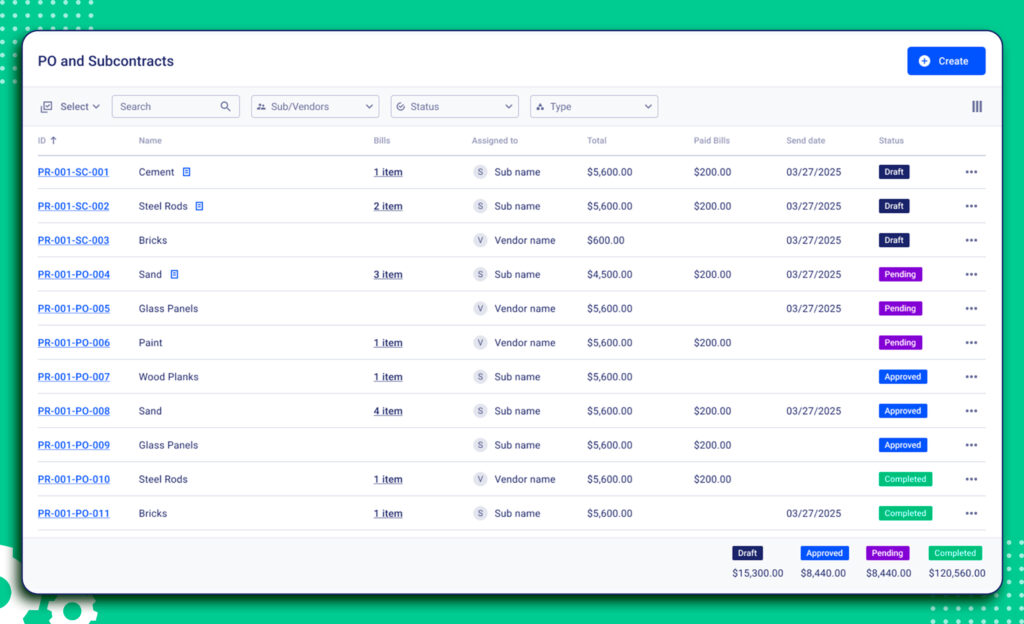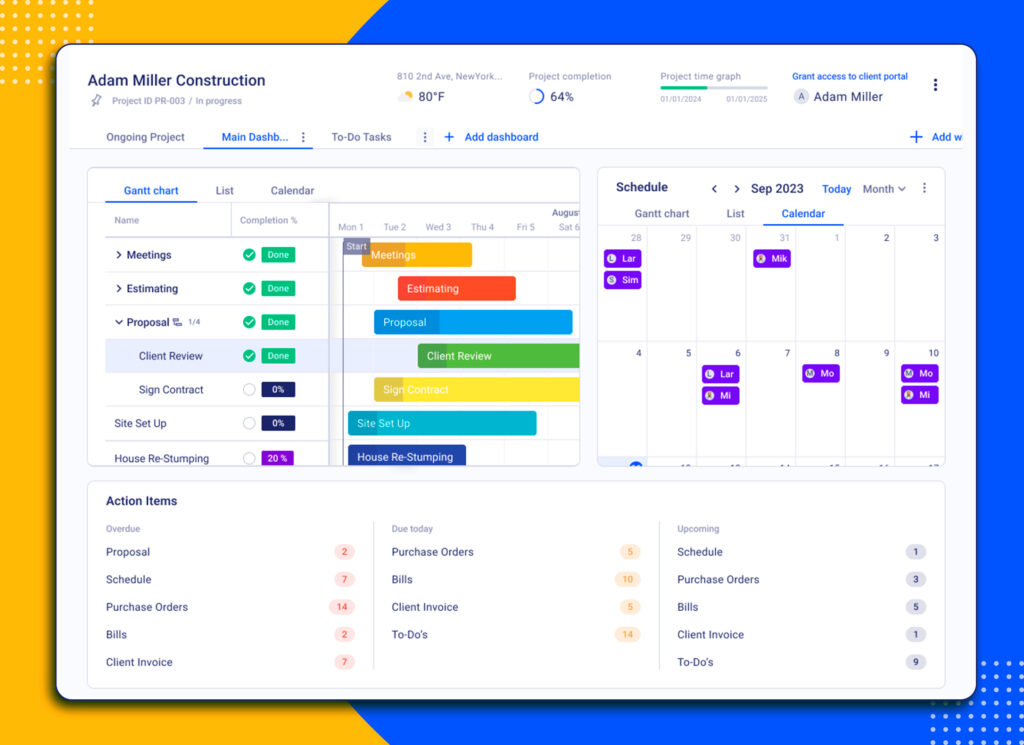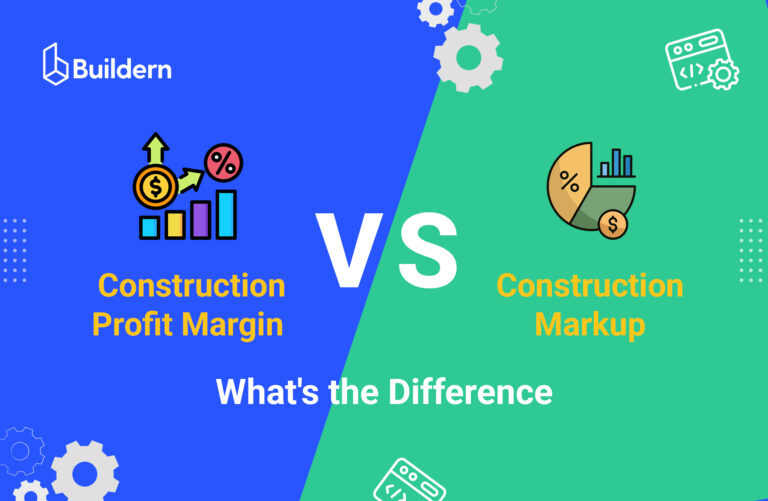Construction Hierarchy: How to Build a General Contractor Team?

Who is who in a construction company? Since construction is one of the most complex industries, the structure of a general contractor firm can be different.
The workflow of a general contractor involves tight deadlines, strict budgets, and subcontractor coordination. With so many things to handle, having a structured management system and a clear construction plan is essential.
So, even for small construction businesses, for example, general contractors managing custom homes, a well-defined team structure can make the difference.
This blog will guide you through the construction hierarchy and will help structure your team for improved efficiency and clearer communication.
Table of Contents
- Corporate Construction Structure vs. Small Building Firms
- Core Team Structure for General Contractor
- Building a Reliable Extended Team
- Bonus Tips for Structuring a General Contractor Team

Corporate Construction Structure vs. Small Building Firms
Large construction companies have a different team structure. This is logical because they work on big projects involving hundreds of staff. Let’s say it is a 15-storey residential or commercial building. There are hundreds of workers, let alone the office staff.
So, it’s a common thing for such firms to operate with CEOs, department heads, and multiple layers of management. Let’s compare these two models.
Large-Scale Builders
Corporate construction firms often take on multi-million-dollar projects such as high-rise buildings or large commercial complexes. Thus, they have a highly layered organization. These companies typically have:
- Owners
- CEO or Executive Board
- Directors (legal department, HR department, marketing department, operations)
- Managers (accountants, construction managers, superintendents, project managers, financial managers)
- Support and entry-level staff (office managers, project assistants, interns, etc.)
Each team handles a specific segment of the project, ensuring efficiency and accountability. Office staff also includes estimators and schedulers.
The division of responsibilities allows these firms to manage several large projects simultaneously. Some can even be across different geographic locations.
When it comes to field staff, large firms employ:
- Site superintendents
- Foremen
- Safety officers
- Quality control inspectors
- Skilled and unskilled laborers (carpenters, electricians, plumbers, masons, and equipment operators).
However, this structure is only viable when the project size and budget justify the overhead of maintaining such an extensive in-house team.
General Contractors
In contrast, general contractors working on custom homes or small/mid commercial projects have leaner teams. The general contractor often juggles the roles of a business owner, a project manager, and a hiring person.
Instead of hiring large in-house departments, the general contractors hire subcontractors for specialized work like HVAC or electrical. This is the reason multitasking is a core skill for a small builder.
A typical small GC team may include a project manager, a foreman, a bookkeeper, and/or an estimator.
Although there are fewer problems with this structure, which has a simpler construction hierarchy and quicker decision making, this also includes building strong relationships and networking with reliable subcontractors. By the way, the subs typically manage their crews, tools, and schedules, reporting to the general contractor.
Of course, it’s a more flexible model to scale the workforce based on project demands. However, GCs also face HR challenges.
Core Team Structure for General Contractor
Although there are a few members in the general contractor’s team. Each member plays a critical role in moving the project forward. The general contractor typically serves as both the owner and CEO. Moreover, the contractor is the central figure to whom all other members report.
Here is the list of the key in-house roles that small building firms usually have:
Project Manager
This person oversees the entire project lifecycle. Everything from planning and procurement to scheduling and client communication. Often, the general contractor doubles as the project manager. All subcontractors typically report to the PM.
Estimator
An expert handling all calculations plays a vital role in the preconstruction phase. The main responsibility is to prepare accurate cost estimates for potential projects. This involves analyzing construction plans, gathering pricing from suppliers and subcontractors.
They can be filled in-house, part-time, or outsourced, depending on the size and workload. Estimators report to General Contractors.
Bookkeeper
These specialists are responsible for the smooth financial management of the project. Bookkeepers manage accounts payable and receivable, issue invoices, track project-related expenses, and process vendor payments. They often generate financial reports to help the general contractor monitor cash flow and maintain budget control across projects.
Field Supervisor/Site Foreman
Manages day-to-day site operations. The person enforces safety protocols, ensures subcontractors’ coordination on site, and monitors progress. The foreman reports to the project manager or a general contractor. This is one of the roles linking the field team and the office.

Building a Reliable Extended Team
In a small team of a general contractor, the success of each project depends on the strength of the extended team. They mostly rely on a network of trusted subcontractors and supplies.
Subcontractors carry out specialized tasks like plumbing, electrical work, or HVAC installation. They intern bring their crews to handle all work at the job site. So, they play a crucial role in the construction hierarchy.
Most importantly, while working with several tradesmen, it’s important to maintain quality and consistency. Coordinating multiple subcontractors with their schedules, scopes, and responsibilities is not an easy task.
Here you can choose either the manual entry of all data into spreadsheets or the use of construction management software. Such platforms have all the necessary tools to coordinate and track subcontractors’ and suppliers’ work. It starts from making bid requests and creating invoices up to built-in messaging.

Beyond tradespeople, building firms also work closely with external specialists such as architects, structural engineers, and interior designers. They are not a direct part of the crew, but collaborating and networking with the specialists very much affects the success of a single project.
Bonus Tips for Structuring a General Contractor Team
Building an efficient team requires much effort. It’s especially stressful when the client base is increasing. The building firm usually faces a difficult choice. Is it right to expand the team or stretch current resources through multitasking to get results?
Here are some practical tips that can help contractors improve how they structure and manage teams.
Outsource Roles When Needed
Legal or marketing tasks are usually outsourced. This allows your core team to stay focused on construction and project delivery.
However, some teams have outsourced bookkeepers and estimators, too. This depends on the number of projects the contractor is running and on the model of this business. Meanwhile, these roles can be cost-effective and lead to disorganization.
Documents, costs, bids, purchase orders, and client invoices can be in different emails, spreadsheets, and various platforms. It’s difficult for outsourced estimators or bookkeepers to get data about the project. In this case, all data is in one place.

Even if they’re not tech-savvy, a user-friendly platform minimizes the chance of misunderstanding and miscalculations.
Balance Your Roles Wisely
Although multitasking is a daily reality for general contractors, some problems may occur. It’s sometimes tough to act as a project manager, scheduler, and estimator at the same time.
Of course, it brings tighter control and lower overhead, but it can quickly become unsustainable, especially if the project load increases.
The key is knowing your limits, as taking on too many responsibilities can slow down progress. Once you feel there are too many tasks, it may be time to delegate or outsource specific roles.
Focus on Building Relationships Over Hierarchy
Unlike large construction companies, small teams have no layered structure. Such teams develop based on strong relationships and trust.
Of course, a clear structure is important for accountability, but prioritizing networking and human connection over hierarchy is more productive.
Eventually, investing time in building strong professional relationships can have a positive effect on projects. A subcontractor who trusts you is more likely to stay flexible.
They can schedule or prioritize your job during a busy season. The same works in the case of suppliers you have worked with for a considerable time. They may move up your delivery or even offer partial shipments in a big queue. Meanwhile, others might stick strictly to standard lead times.
These may seem as some insignificant details, but in the long-term perspective, they can prevent bigger problems.
Establish Clear Communication
In a team with one person performing several tasks, there should be transparent and consistent communication. The general contractor’s team cannot afford weeks to get a reply to the bid request or change order approval.
Poor communication harms all phases of the project from procurement to delivery. Since different tasks are interrelated, prompt answers are needed, preferably within one platform. The reason is that this prevents duplicated work and costly rework. Ensuring every team member knows who to report to and where to get information on the next phase of a project.

The right document management also simplifies communication around critical files. Whether it’s contracts or RFIs, all files are stored in one place.
Team members, a project manager, or a subcontractor have easy access and do not have to call each other to clarify simple details.
Train Your Team Continuously
Continuous training in small teams can make a big difference. To remain competitive, it’s not enough for team members to rely solely on traditional skills. They must also become comfortable with digital tools to keep up with modern demands.
Let’s say you’re using software tools to handle bids, approvals, and daily reports. If the estimator or site foreman doesn’t fully understand the system, information gaps are inevitable.
Overall, organizations are holding training. For example, the Construction Management Association of America (CMAA) offers certifications, resources, and training programs.
Even those who aren’t tech-savvy can work in a centralized platform when guided properly. Just a few hours into training, your staff can pay off quickly. Plus, when trained on one project, they can apply the skills during future ones. So, in any case, you win.
What is the construction roles hierarchy?
Overall, it’s a structured chain of command within a construction company or project. Hierarchy defines the roles and responsibilities of each team member. However, there is a big difference between a corporate construction company and a general contractor.
Is there a strict hierarchy in construction?
It depends on the size and nature of the company. Large companies often follow a strict, layered hierarchy. They traditionally have defined roles and departments. In contrast, small to mid-sized firms have a flattened structure. In particular, custom home general contractors take on multiple roles, and hierarchy and reporting are more flexible.
How do subcontractors fit into the construction hierarchy?
Subcontractors operate as independent tradesmen. They are hired for a specific project and a particular task. They can be in-house workers, for example, framers. Subcontractors either report to the general contractor or a project manager as well.
How can technology support the team hierarchy?
Construction management software helps centralize communication, organize documents, assign tasks, and track progress. Tools like Buildern allow teams to streamline workflows and maintain clarity, even when team members are working remotely or juggling multiple responsibilities.



